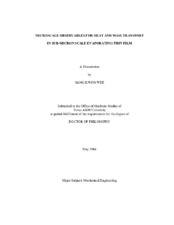| dc.description.abstract | A mathematical model is developed to describe the micro/nano-scale fluid flow and heat/mass transfer phenomena in an evaporating extended meniscus, focusing on the transition film region under nonisothermal interfacial conditions. The model incorporates thermocapillary stresses at the liquid-vapor interface, a slip boundary condition on the solid wall, polarity contributions to the working fluid field, and binary mixture evaporation. The analytical results show that the adsorbed film thickness and the thin film length decrease with increasing superheat by the thermocapillary stresses, which influences detrimentally the evaporation process by degrading the wettability of the evaporating liquid film. In contrast, the slip effect and the binary mixture enhance the stability of thin film evaporation. The slip effect at the wall makes the liquid in the transition region flow with smaller flow resistance and thus the length of the transition region increases. In addition, the total evaporative heat flow rate increases due to the slip boundary condition. The mixture of pentane and decane increases the length of the thin film by counteracting the thermocapillary stress, which enhances the stability of the thin film evaporation. The polarity effect of water significantly elongates the thin film length due to the strong adhesion force of intermolecular interaction. The strong interaction force restrains the liquid from evaporation for a polar liquid compared to a non-polar liquid. In the experimental part, laser induced fluorescence (LIF) thermometry has been used to measure the microscale temperature field of a heated capillary tube with a 1 mm by 1 mm square cross section. For the temperature measurement, the calibration curve between the temperature and the fluorescent intensity ratio of Rhodamine-B and Rhodamine-110 has been successfully obtained. The fluorescent intensity ratio provides microscale spatial resolution and good temperature dependency without any possible bias error caused by illuminating light and background noise usually encountered in conventional LIF techniques. For the validation of the calibration curve obtained, thermally stratified fields established inside a glass cuvette of 10 mm width were measured. The measurement result showed a good agreement with the linear prediction. The temperature measurement in a 1 mm capillary tube could provide the feasible method of temperature measurement for the thin film region in the future. | en |


